
Cauterizing Procedure Page Menu: 1 2 3 4 5 6 7 8 Next>>
Cauterizing Procedure During the Golden Age of Piracy, Page 4
Medicinal Uses For Cautery
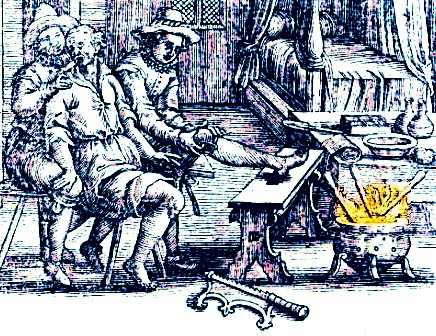
Cauteries Ready for Amputation, From Opera Quae Extant Omnia
William Fabry, By Marcus Severinus, p809 (1682)
There was quite a variety of procedures in the period and near-period surgical manuals that could be performed using cauterization. Some of them were only mentioned by a single surgeon, which makes it less likely that they were in widespread use during this time, but most of them are mentioned by several surgical writers.
Among the uses for red hot irons and burning medicines were: cutting, elimination of poisons, treating decayed teeth, opening apostemes (swollen abscesses), removing rotten bone, creating fontenels (artifically created ulcers thought to allow the escape of "bad" humors from the body), removing unwanted flesh, treating certain illnesses, stopping viscious flows from wounds and eliminating gangrened tissue. Let's look at each.
Cautery Uses: Cutting
A type of sharp-edged cautery iron was sometimes used to cut flesh with the idea that the hot iron would seal the vessels as it sliced through, preventing unnecessary bleeding. Although this sounds like a practical idea in some ways, it does not seem to have found favor amongst the surgeons during the golden age of piracy.
In fact, only sea-surgeon John Woodall mentions this process, noting that it had "bin comonly used by the ancients in dismembering, namely to cauterize sometimes the whole end of the stumpe, and sometimes onely veines and arteries, and doubtlesse with good warrant"1. Yet Woodall himself preferred not to use cauterizing irons and no other author mentions this procedure. Even so, such cauterizing cutlery blades appeared in several surgical manuals from around this time period.
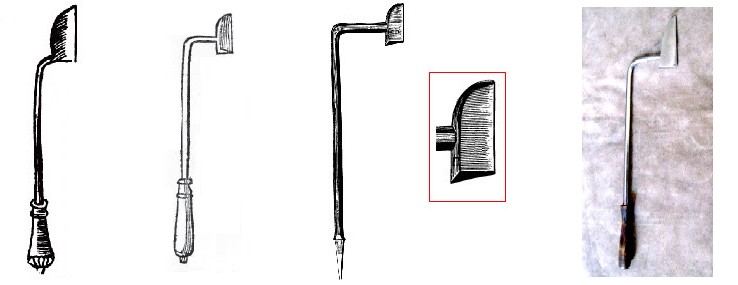 Cutlery Cautery Irons - From Left: Ambroise Paré (1649), Pierre Dionis (1740), Jacques Guillemeau (1597), and an Iron forged by Adam Cyphers |
1 John Woodall, the surgions mate, p. 10
Cautery Uses: Eliminating Poison
Cauteries could

Photo: Tim Vickers - The Black Mamba Snake - Poisonous
also be used to eliminate poisons in the body. Hezekiah Crooke, drawing from the work of Ambroise Paré, explains that cauterizing irons were "alwayes fittest where the matter concluded is poisonous, whether it be an Apostemation (swollen abscess), or upon the biting or stinging of poysonous creatures; for fire is a prompt worker, vehement also and sudden, and the Eschar [burnt scar formed by the cautery iron] will sooner loosen and fall: Beside the vehemencie of actuall fire makes a greater impression upon the adjacent parts, and keeps and issue longer open"1, thus allowing the poison to exit the body with the 'issue', or flowing out, of other bodily humors.
Paré does warn that cauterizing poisoned wounds "onely when the poyson is in or neere the suface, and not when it hath insinuated it selfe deepe into the body. For if the actuall Cautery reach the poyson, it will extinguish it; if it cannot reach it, it will exasperate it more"2. He says that "there is frequent use of these actuall Cauteries" in treating syphilis and the poisons it brings into the body3, although he does not say how.
Photo: Wiki User ZooFari - Mediterranean House Gecko - Not Poisonous
In the narrative of his travels, sailor Alexander Hamilton mentions the use of cauteries in this fashion for treating urine wounds from something he calls a Jackoa. "It [the Jackoa] is very malicious, and pisses at every Thing that offends it, and wherever the Liquor lights on an animal Body, it presently cankers the Flesh, unless immediate Cauterizings are used, and if that cannot be had, the Piece must be cut out, for, if once it blisters the Skin, there is not cure for it afterwards"4. However, the veracity of Hamilton's narratives are frequently questionable, and it turns out that the Jackoa ... or 'Gecko'... is not at all venemous.5
1,2,3 Hezekiah Crooke, An Explanation of the Fashion and use of Three and fifty Instruments of Chirurgery, Gathered out of Ambrosius Pareus, p. 5; 4 Alexander Hamilton, British sea-captain Alexander Hamilton's A new account of the East Indies, 17th-18th century, p. 419-20; 5 "Q: Are geckos poisonous?", answers.com, gathered 9/3/14
Cautery Uses: Treating Tooth Decay
Cautery was also seen as a method of last resort in treating a rotted tooth in some cases. Ambroise Paré explains
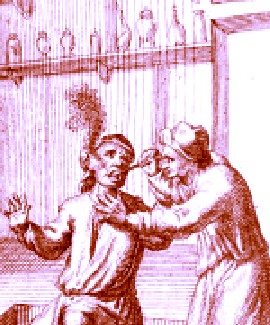
Cauterizing a Tooth, from
The Martyrdom
of Mercury
J. Sintelaer, p.104 (1709)
that "if the tooth bee hollowed, and that the patient will not have it pull'd out, there is no speedier remedie, then to put in caustic medicines, as oil of vitriol [sulfuric acid], aqua fortis [nitric acid in water], and also a hot iron; for thus the nerv is burn't in sunder, and loseth it's sens[e]."1 Writing around the same time, French surgeon Lazere Raviére noted that when the decay penetrated "the inner cavity of the tooth, to effect the cessation of pain, it is necessary to burn the nerve with the actual cautery, or with aqua fortis, or with oil of vitriol. If this be repeated several times, the tooth gradually falls to pieces."2
Closer to our area of interest, sea surgeon John Moyle expresses the same idea, explaining that when "pain do[es] return to rotten and hollow Teeth, as often as the Air gets into them and offends the Nerve, or Crums get in and hurt the Nerve, in this case you may try to cure it by actual or potential Cautery; the actual is heating the small end of your Probe red hot, and so applying it into the hollow of the Tooth to burn or Sear the Nerve, but let it be done with care, that you touch not the Mouth or Gums with it. ...The potential [cautery to be used] is Ol. Vitriol: put into the Tooth on a pellet of Lint; and here must care be taken too, lest it touch the Mouth or Gums."3
1 Ambroise Paré, The Workes of that Famous Chirurgion Ambrose Parey, p. 414; 2 Vinenzo Guerini, A History of Dentistry From the Most Ancient Times Until the End of the Eighteenth Century, p. 229; 3 John Moyle, The Sea Chirurgeon, p. 242-3
Cautery Uses: Opening Apostemes
"Sometimes the Patients nicity, sometimes the place, sometimes the condition of the Tumor, require that Knife and Lancet be forborne, and then Apostemations may be opened with Cauteries. They are either actuall, or potentiall. The actuall Cautery is an hot iron." (Hezekiah Crooke, An Explanation of the Fashion and use of Three and fifty Instruments of Chirurgery, Gathered out of Ambrosius Pareus, p. 5)
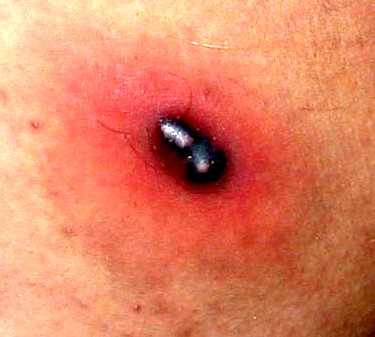
Photo: Sven Teschke - A Swollen Abscess
Apostemes are swollen abscesses filled with purulent matter such as pus. A cautery iron could be a quick and dirty way to open such swellings without giving them the ability to rapidly re-close once all the fluid drained, although it is not recommended in any of the books under study after sea surgeon John Woodall's book, last published in 1655.
Woodall does not actually use this method, noting that cautery irons were "used commonly of the ancient Surgeons of former ages for the opening of Apostumes. And surely they are far better in my judgement for the good of the Patient in many Apostumes then the Launcet [lancet blade]: and yet I confesse I make no use of them my selfe in that kinde"1. Woodall later admits that his main reason for not using cautery irons, even though he seemed to think they would work better, was due to the fear it instilled in the patient and the disapproval of anyone who was watching or who heard about the procedure.
1 John Woodall, the surgions mate, p. 10-1
Cautery Uses: Removing Rotten/Damaged Bone
Cauterizing bones were a procedure that was used both to burn out the caries (Latin for 'rot') as well as to scale - or remove the dried out end of - the bone after amputating a limb to prevent the formation of such caries.
Ambroise Paré explains that when dressing the stump after amputation, a
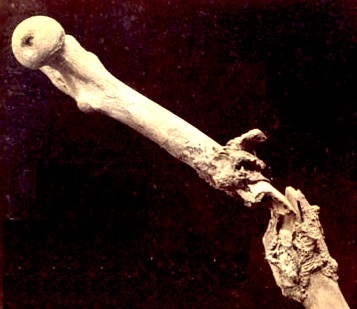
Bone Exfoliation and Necrosism, From Otis Historical
Archives of National Museum of Health and Medicine
surgeon "must use diligence to procure the falling away of the ends or scalls [scales] of the bones... [the surgeon must] have actuall cauteries, that is, hot irons in using of which you must have a speciall care that you touch not the sensible [sound] parts with fire; neither must the [scales of the] bones themselves bee forcibly pluckt off, but gently mooved by little and little, so that you shall thinke you and the patient have exceedingly well performed your parts if they fall away at the thirtyeth day after the Amputation."1
Sea surgeon John Woodall again comments that this procedure to scale the bone after amputation was "comonly used by the ancients in dismembering, namely to cauterize sometimes the whole end of the stumpe... but in that case they are wholly now forborne, for reasons aforesaid, and for that a more pleasant course is knowne both for the Patient and the Artist"2. Woodall's reason for not using cauterization seems to again be concern for the comfort of the patient, although he still suggests the surgeon have cautery irons available for possible use.
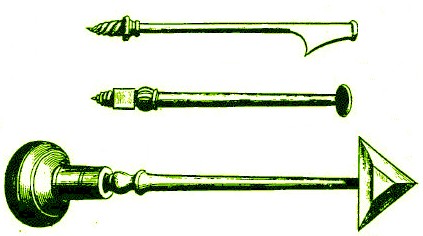
Some Raspatories With an Interchangeable Wooden Head, from
Thesaurus Chirurgiae by Paul Barbette, p10 (1687)
All of the period commentary on using cautery irons to treat caries in the bones come from esteemed English military surgeon Richard Wiseman. Wiseman was one of the few proponents of cautery iron use during this period and they appear repeatedly in his works.
He suggests that when "Caries be in the great Bones, and lie deep, and be subject to the inflowing of Matter; your speediest way will be by manual Operation, viz. either by Rugins [rugine - scraping or filing them with a metal raspatory] or actual Cautery. If you can come easily to the Bone to scrape it, as in the Cranium, that way will be most proper."3 Of the two methods Wiseman presents, cauterization does seem preferable to the slower, jerky scraping and filing of a rotted bone.
3 Ambroise Paré, The Apologie and Treatise of Ambroise Paré, p. 155; 2 John Woodall, the surgions mate, p. 10; 3 Richard Wiseman, Of Wounds, Severall Chirurgicall Treatises, p. 183
Cautery Uses: Creating a Fontanel or Issue
A fontanel or issue was used to encourage the flow of bad humors out of the body. It involves intentionally making a hole in the skin which is kept opened and irritated by the insertion of a foreign object into the wound - such as a pea. This is kept in place with a piece of silk threaded over top of it through the skin on either side of the incision. Fontanels could be made anywhere on the body, although they were often put in the nape of the neck. One way to create the hole in the skin for a fontanel was with a cautery iron.
Jacques Guillemeau enthused that "we may conjecture and suppose, that the Cautereyes, & fontanelles, weare invented, following nature therin, ther throughe to give passage, to that which is contrary, &
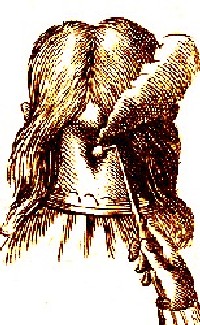
Using a Cautery to Create a Fontanel
From From
L'Arcenal de Chirurgie by
Jacques
Guillemeau,
p. 156 (1597)
opposite unto her [he's referring here primarily to bad humors], & whereof she is perturbated, & molested, it be ether in quallity, or in quantitye, as heerafter we will farther speake of."1 Richard Wiseman mentions that fontanels could be made "by Caustick [potential cauteries], and afterward incarne[d] and cicatrize[d] with much ease to the Patient."2 Wiseman seems to be suggesting that using potential or chemical cauteries to make issues would be more comfortable and possibly would work better.
German military surgeon Matthias Gottfried Purmann gives the most detail on making fontanels with cauterization.
There are several ways of making these Fontanels, in Italy and France they commonly use Actual Cauteries, which are Irons made with a small round Head in Form of an Acorn, which being made very hot, and the Skin touched with it, where you design to make the Fontanel, it will raise a Blister, which being cut, and a Pea put into it, with a thin Piece of Silver upon the Pea, and Bolsters and a Bandage over the Silver Plate, to make the Pea work its way downward; let it continue so for two or three days, and at the next opening you will find the Issue made.3
The advantage of using cauteries to create the wound in the minds of these surgeons was likely that the wound healed more slowly than one made by incision and so the bad humors could run for a greater period of time without having to reopen the wound. Of course, today we know that most running open sores are actually infected which is what produces the issue, but this was not understood at the time.
1 Jacques Guillemeau, The French Chirurgerie, p. 39-40; 2 Richard Wiseman, Of Wounds, Severall Chirurgicall Treatises, p. 408; 3 Matthias Gottfried Purmann, Churgia Curiosa, p. 21-2

